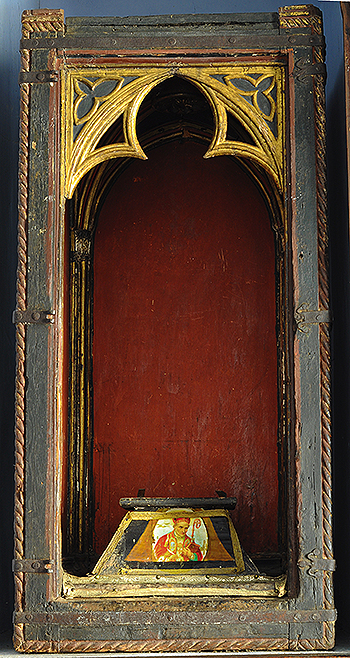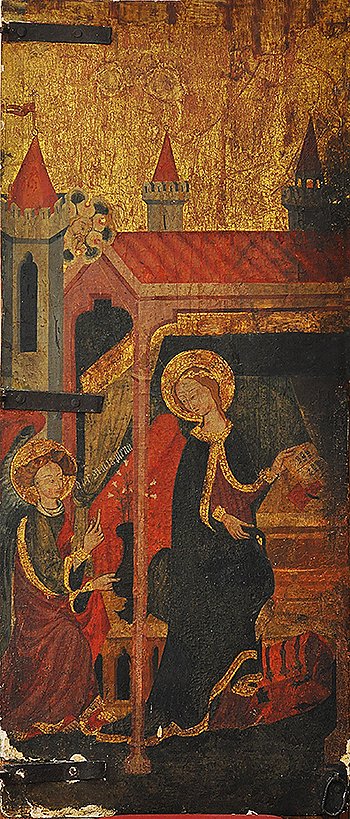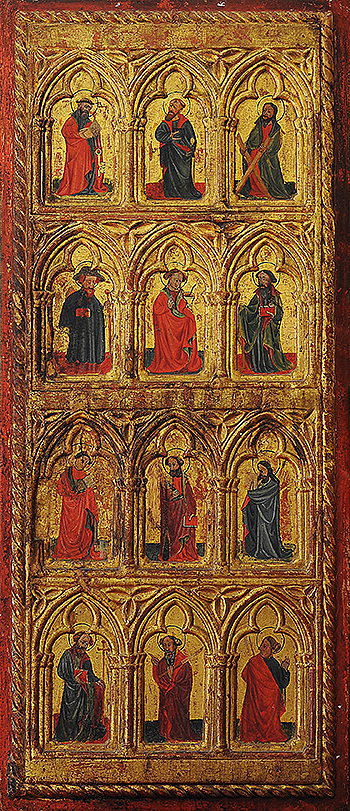4 October
lecture series
SANCTUARIES IN ESTELLA LAND
The Sanctuary of Le Puy: art and history
Mrs. Mercedes Osés Urricelqui (Center of programs of study of Tierra Estella) and
D. Antonio Ros Zuasti (IES Tierra Estella)
Since Gutiérrez Eraso raised the possibility of a close relationship between the city of Puy en Velay (then Occitania) and the main settlers of the foundation of Estella, until today, there is no longer any doubt that the Franks who came attracted by the regional law brought with them all the symbols and beliefs of their culture.
Among other devotions to saints and virgins, the Occitans were accompanied by the veneration of the Virgin of Le Puy. Legend tells of the appearance of the image in the year 1085, which may have contributed to the successful foundation of the city. However, documentation does not mention the Shrine of Our Lady of Fair Love del Puy until well into the 12th century, around 1171. It must have been a small church in poor condition because a few years later, in 1174, the bishop of Pamplona gave the church to the brotherhood of "los sesenta o de Santiago" for its rebuilding. This association, composed at the beginning, mainly by Franks, was very controversial. It took part in the flag fights that divided the city in two. On one side were the Sesenta, on the other those of the brotherhood of the monastery of Salas. These fights would later lead to clashes between the Ponces and the Learzas. The kings had to do their utmost to impose peace. So much so that they had to suppress the brotherhood of "Los Sesenta".
The 14th century seems to be the beginning of the splendor of the church of Le Puy. Charles III pacified the city and strengthened the union of the various burgs in a single town hall. The royal favors benefit the sanctuary of Le Puy. The kings granted it the very important rents of the dye mill, located in the Ega river and that used to be leased to Jewish families. It was probably at that time that the Gothic carving of the Virgin of El Puy, which we can enjoy today, was commissioned.
A new era will be the one that officially considers the Virgin of Le Puy as the patron saint of the city. The enthusiasm will come from the fervor increased after the battle of Fuenterrabía in 1638. The soldiers of Estella who had come to the call of King Philip IV entrusted themselves to the Virgin of Le Puy. As they all returned, they considered it a miracle. It was agreed to celebrate the festivities of the Virgin on September 8 and the first Saturday of August.
The Carlist wars tried to turn the Puy into a symbol of the pretenders. The Carlist generals were shot there in 1839, so the Carlists went there on pilgrimage. Charles VII during his stay in the city, in 1874, gave to the Virgin of Le Puy his saber staff which is still kept next to the treasury of the basilica.
THE STATUE OF THE VIRGIN OF PUY
Regarding the carving of the Virgin of Puy, it is made of wood, covered with silver plate and polychrome on the faces and hands; it is a Gothic image, probably from the 14th century, which replaced the original carving, possibly Romanesque and similar to the original carving of Puy en Velay. We do not know why and when the substitution was made. Apparently in a cavity of the head it keeps a cylindrical wooden box with a lid in which, according to the Calf of Puy, relics and the remains of the previous image were hidden.
The oval face of the Virgin stands out, inspired by French models, and the mouth pointing a slight smile that gives it great sweetness; it presents a serene and smiling attitude. The Child, seated on the left knee of the Virgin, blesses.
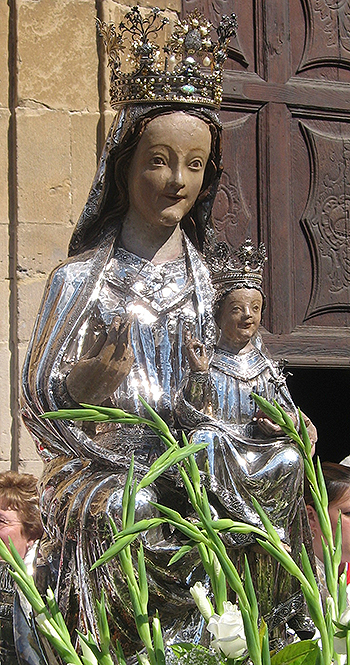
Photo 1. Virgin of Puy de Estella (Photo Juan Terrados).
The Gothic image has undergone changes, due to the devotion of the faithful who have tried to dignify it over the centuries. In the 17th century the golden silver crown and the silver moon average were added to the Virgin's feet. In the 18th century and until 1886 it followed the example of so many other medieval images that are dressed with cloaks, and an oval that leaves the face uncovered. At the end of the 19th century and beginning of the 20th century, the silver plating that covers the image was replaced.
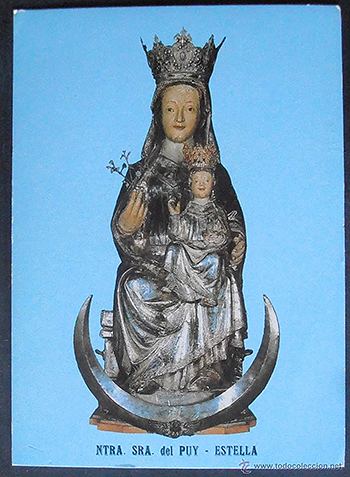
Photo 2. Virgin of Puy

Photo 3. Virgin of Le Puy with mantle (18th century-until 1886).
THE GOTHIC ARK OF THE VIRGIN OF PUY
Until the 17th-18th century, when the image was placed in an altarpiece, the Virgin of Le Puy was kept inside an oak chest, gilded and polychrome, of Gothic origin, in the chapel of the basilica. The ark, with vertical disposition, remained closed so that only the painting of the Annunciation, which was made on the front of the door of the ark, was shown. On solemn feasts, the door of the ark was opened and during that day the carving of the Virgin of Le Puy could be seen.
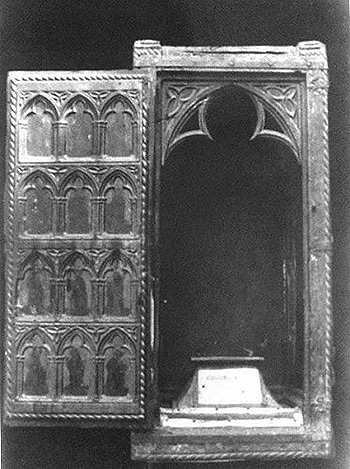
Photo 4. Gothic ark-exhibitor (late XIV-early XV century)
|
|
|
|
|
Photo 5. Gothic Arca-exhibitor (Juan Terrados) |
Photo 6. Outer face of the door (Sergio Casi) |
Photo 7. Interior face of the door (Sergio Casi) |
At present, the door and the ark are separated and it is not known since when. It is decorated on both sides with paintings in the International Gothic style of the first third of the 15th century, a style characterized by the use of a rich coloring, with abundant gilding, where the figures are stylized, undulating and movement appears, mainly reflected in the clothing. The exterior face of the door is painted with a scene of the Annunciation and the interior face of the door presents twelve niches carved with three-lobed Gothic arches, which frame the painted images of the apostolate, with their identifying attributes, on a golden background and rich coloring of reds and blues.
THE PUY SANCTUARY
Regarding the sanctuary, nothing remains of the medieval building built by King Sancho Ramirez in the twelfth century. In the middle of the 17th century, the construction of a new Baroque style building began. The work continued throughout the 18th century and resulted in a church with a Latin cross plan of no particular architectural value.
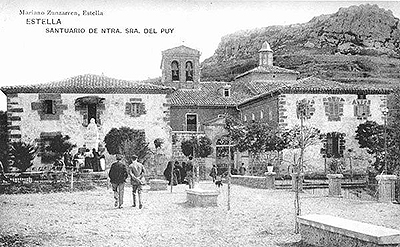
Photo 8. The sanctuary of Le Puy in 1910. Baroque building.
In 1928 the prior informed about the imminent danger of the building sinking and it was decided to build a new one. The project was commissioned to the Pamplona architect Víctor Eusa, who built it submission in 1929.
On May 25, 1930 the first stone was laid and in 1932 the roof was already in place and Mass could be celebrated, although all the decoration was still pending.
After the parenthesis of the Civil War and the hardest years of the post-war period, in 1949, the initial plan was remodeled by the same architect, culminating the work in 1951, using the last years in the decoration of the interior. It was inaugurated on the feast of the Virgen del Puy in 1952 by the bishop of Pamplona. The estimated expense is around one million pesetas.
position The decoration and furnishings were the responsibility of numerous artisans from Estella (Cruz Ganuza and Félix Basarte, scaffolding and masonry; Marino Echeverría, the grilles of the ambulatory and the communion rail; Joaquín Errazquin, the central chandelier, a gift from Nicolás Ruiz de Alda; Agustín Chasco, the stonework; Fermín Errazquin, the tinsmithing; Juan Domínguez, the electricity; Felipe Poyal, the carpentry; Felipe Poyal, the carpentry), although the most important works were commissioned to the most prestigious firms (plaster decoration to Francisco Letamendía, from San Sebastián; marble and alabaster altar to the Barcelona workshop of Ricardo Andreu; baldachin to the Barcelona workshop of Pedro Corberó and the stained glass windows, to the Madrid-based Casa Maumejean).
The new building has a star-shaped plan. This star shape is repeated in the wooden roof, in the decoration (central lamp) and in the furniture, and alludes to the stars that propitiated the finding of the image of the Virgin of Puy. Tradition that was reflected in some verses placed in the old chapel that read: This is the star that came down from the sky to Estella to repair it.
Light and its effect was one of the architect's main concerns. The interior is strongly luminous since the wall opens with numerous stained glass windows, which together with the material employee for cladding, brick, and the decorative pointed forms, give the whole a lightness aspect.
This basilica of Le Puy can be considered one of the most important works of Victor Eusa (influenced by Viennese modernism).

Photo 9. Interior of the Basilica of Le Puy.

